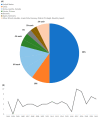Human Granulocytic Anaplasmosis-A Systematic Review of Published Cases
- PMID: 35889152
- PMCID: PMC9318722
- DOI: 10.3390/microorganisms10071433
Human Granulocytic Anaplasmosis-A Systematic Review of Published Cases
Abstract
Anaplasma phagocytophilum is an emerging, Gram-negative, obligate intracellular pathogen that is transmitted by a tick vector. Human infection ranges from asymptomatic to severe disease that can present with pancytopenia, multiorgan failure, and death. The aim of this systematic review is to analyze case reports and case series reported over the last two decades in peer-reviewed journals indexed in the Medline/PubMed database according to the PRISMA guidelines. We found 110 unique patients from 88 case reports and series. The most common mode of transmission was tick bite (60.9%), followed by blood transfusion (8.2%). Infection was acquired by blood transfusion in nearly half (42%) of the immunocompromised patients. Most patients reported fever (90%), followed by constitutional (59%) and gastrointestinal symptoms (56%). Rash was present in 17% of patients, much higher than in previous studies. Thrombocytopenia was the most common laboratory abnormality (76%) followed by elevated aspartate aminotransferase (AST) (46%). The diagnosis was most commonly established using whole-blood polymerase chain reaction (PCR) in 76% of patients. Coinfection rate was 9.1% and Borrelia burgdorferi was most commonly isolated in seven patients (6.4%). Doxycycline was used to treat 70% of patients but was only used as an empiric treatment in one-third of patients (33.6%). The overall mortality rate was 5.7%, and one patient died from trauma unrelated to HGA. The mortality rates among immunocompetent and immunocompromised patients were 4.2% (n = 4/95) and 18.2% (n = 2/11), respectively. Four of the six patients who died (66.6%) received appropriate antibiotic therapy. Among these, doxycycline was delayed by more than 48 h in two patients.
Keywords: Anaplasma phagocytophilum; Borrelia burgdorferi; anaplasmosis; coinfection; human granulocytic anaplasmosis; tick borne disease; ticks.
Conflict of interest statement
The authors declare no conflict of interest.
Figures
References
-
- Dumler J.S., Barbet A.F., Bekker C.P.J., Dasch G.A., Palmer G.H., Ray S., Rikihisa Y., Rurangirwa F.R. Reorganization of genera in the families Rickettsiaceae and Anaplasmataceae in the order Rickettsiales: Unification of some species of Ehrlichia with Anaplasma, Cowdria with Ehrlichia and Ehrlichia with Neorickettsia, descriptions of six new species combi. Pt 6Int. J. Syst. Evol. Microbiol. 2001;51:2145–2165. doi: 10.1099/00207713-51-6-2145. - DOI - PubMed
Publication types
LinkOut - more resources
Full Text Sources



